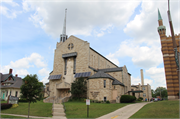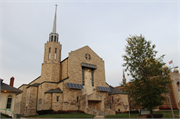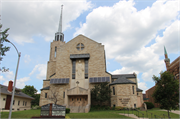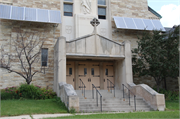| Additional Information: | "A 'site file' exists for this property. It contains additional information such as correspondence, newspaper clippings, or historical information. It is a public record and may be viewed in person at the Wisconsin Historical Society, State Historic Preservation Office.
2023- resurveyed as part of Milwaukee Houses of Worship thematic survey. Alterations to front facade.
2015- ""Our Savior's is located on a long narrow lot on the north side of W. Wisconsin Avenue and faces south, separated from the road by the terrace, sidewalk, and a sloping lawn. Concrete steps at the southeast and southwest corners of the property lead from the sidewalk to the main entrance, and a curved concrete walkway continues around the east and west elevations of the church. A driveway on the east side provides access to a large parking lot at the rear of the building, which is also accessible via Wells Street. A modern sign is located at the center of the front lawn. Our Savior's is a two-story, front gable, Neogothic Revival church. Construction started in 1951 and was completed in 1954. The walls are clad in Lannon stone and rest on a concrete foundation, and the roof is covered in asphalt shingles with copper gutters and flashing. The eaves feature stone dentils and gable ends have stone parapets. Massing consists of a cruciform plan with a central sanctuary with clerestory windows that rise above multiple one- and two-story projections on the east and west (side) elevations. A two-story, flat roof, office wing is located at the rear (north) of the building. A large octagonal steeple sits atop a square tower at the building's southwest corner and features a zinc-clad spire topped by a cross. A stone belt course spans the front (south) facade and wraps around the east and west elevations, incorporating the headers of doors and windows on the lower story. Stone veneer pilasters separate the paired, narrow, round-arch, stained-glass windows of the clerestory, and stained-glass windows are found on the east and west elevations as well. Basement windows are paired, six-over-six, metal, double-hung units, and windows elsewhere are four-over-four, metal, double-hung units in single, double, and triple configurations; windows feature flat stone sills, and stained-glass units also have flat stone headers. The main entrance is centered on the front (south} facade, and a flat roof stone portico with a peaked parapet topped by a ringed cross shelters the doorway, accessed via stone steps with metal handrails. The entrance consists of a central pair of wood doors with ornamental strap hinges, flanked by a single door on either side. Above the entrance, a ribbed copper awning shelters a pair of tall, narrow windows, between which a large stone statue of the Inviting Christ rests atop a pedestal inscribed ""Come unto Me"" (Matthew 11 :28). Two photovoltaic solar panels (installed in 2008) flank the statue's base. Above the statue, a stone cross quarters the stained-glass oculus window in the peak of the south gable. A one-story polygonal chapel wing projects on the east side of the front facade, and stone stairs at the chapel's southeast corner lead to a secondary entrance. A two-story gable wing projects at the south end of the east (side} elevation, and a side entrance at its base has a flat-roof portico supported by stone veneered posts. The east side aisle and polygonal east transept project beyond the plane of the sanctuary main block, and both feature stained-glass windows in paired and triple configurations. On the west elevation, a one-story hip roof is located at the southwest corner in the junction of the main block and the base of the steeple. The west side aisle projects beyond the sanctuary block, and a concrete exterior stair provides access to the south elevation of the west transept and the basement below. An additional basement entrance is located near the northwest corner, at the junction of the office wing and main block. The office wing spans the rear (north) elevation beneath the north gable of the sanctuary, which features a large, round-arch, stained-glass window beneath a stone veneer cross. The office wing consists of several flat roof sections that vary slightly in height and are separated by flat stone parapets. A tall, stone-veneer, exterior chimney is located near the northeast corner. A porte-cochere and covered, handicap-accessible walkway (added in 1989) extend from the rear entrance into the parking lot. Interior The main entrance on the front (south) facade opens onto a set of steps leading to the narthex (see floorplans). The women's restroom and a lounge area are located at the west end of the narthex, while a small shop area is located at the east end. Stairs to the basement and organ loft are located at the northeast and northwest corners of the narthex. A doorway at the southeast corner of the narthex leads to a small polygonal chapel with a vaulted ceiling and oak pews on either side of a central aisle. A polychrome replica of the iconic Scandinavian Lutheran Christus statue sits on an altar atop a raised dais, flanked by stained-glass windows. 3 The wall separating the narthex and main sanctuary has a central double door flanked on either side by a band of multi-light casement windows. The sanctuary is oriented north-south and the nave has a barrel-vaulted ceiling above stained-glass clerestory windows and side aisles on the east and west walls. The walls are of limestone and oak pews line both sides of a central aisle. Shallow one-story transepts project on the east and west (side) elevations, and the chancel is located at the north end. A low wood railing surrounds the marble altar, located on the north wall of the chancel atop a raised dais, and the carved and paneled wood reredos behind it features Gothic-inspired details. An arched stained-glass window is located above the altar. A removable semicircular platform with a wooden railing is located at the north end of the nave, below the chancel, and a pulpit is located at the southwest corner of the chancel. The organ loft is located at the south end of the sanctuary and contains a 1963 Casavant pipe organ. Stained-glass windows are found throughout the sanctuary, both at the clerestory level and below in the transepts and side aisles. Doorways on either side of the chancel provide access to stairwells, the vestry, and office spaces. The church offices are located at the rear of the building, and the north entrance from the parking lot opens into a lobby area. The reception desk, restroom, sacristy, and elevator are accessible from the lobby, and a hallway behind the chancel leads to conference rooms and a nursery. Offices and a choir room occupy the upper floor of the rear wing. The majority of the basement level is occupied by a large, open meeting hall separated from side aisles by large tile-clad columns. Accordion partitions enable the space to be further subdivided. Throughout the basement, glazed tile surrounds the window openings and covers the lower half of the walls. A youth room is located at the southern end, and restrooms are located in the southeast and southwest corners. Three sets of double doors in the north wall of the meeting hall provide access to the serving hallway. A counter runs along the north wall of the hallway beneath a row of service windows with sliding wood doors. The kitchen and an additional meeting room occupy the north end of the basement. During the site visit, surveyors were given access to the basement areas, although the spaces were in use and photography was therefore not permitted."" -""Our Savior's Lutheran Church,"" WisDOT #2190-00-00, Prepared by Mead & Hunt, Inc. (2015).
2014- ""Our Savior’s Lutheran Church is a Contemporary church with Neo-Gothic Revival influences that was constructed between 1952 and 1954. Designed by the noted local church architect Hugo Haeuser, it is a large, rectangular building clad in local Wisconsin lannon stone with limestone details. It has a front gable roof clad in asphalt shingles and a tall octagonal spire on the west side of the building. Several smaller one- and two-story wings and chapels surround the building. Each is a different size and topped by a hip roof. The main entrance is centered on the south facade. It is covered by a simple, front gable, limestone roof. Above the main entrance is a large, two-story, stone sculpture of the “Inviting Jesus,” designed by Milwaukee artist Dick Wilken and carved by Adolph Raeger. The building’s stained glass windows were designed by Karl Fridlemeier. The parish dates to 1858 as an early Norwegian Lutheran church in Milwaukee. The parish moved to the current site in 1952."" -""W Wisconsin Ave, 20th St-35th St"", WisDOT #2190-00-00, Prepared by Mead & Hunt, Inc. (2014)." |
|---|





